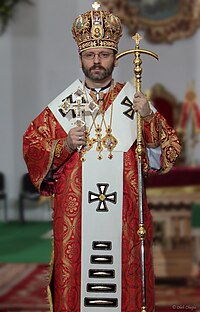Major archbishop

| Part of a series on |
| Eastern Christianity |
|---|
 |
In the Eastern Catholic Churches, major archbishop is a title for a hierarch to whose archiepiscopal see is granted the same jurisdiction in his autonomous (sui juris) particular Church that an Eastern patriarch has in his, but is at the same time below the rank of Patriarch in the ranking.[1]
The title is used for archbishops of episcopal sees that were founded more recently than the patriarchal sees and are therefore less prestigious. Consequently, there are differences between the two offices. Major archbishops rank immediately below patriarchs in the order of precedence of the Catholic Church.[2] If made members of the College of Cardinals, major archbishops join the order of Cardinal-Priests, whereas patriarchs of the east join the highest order, Cardinal-Bishops. Like patriarchs, major archbishops are elected by the synod of the sui iuris Church, but their election requires confirmation by the Pope, not mere notification and granting of communion required of patriarchs.[3]
The title was first granted to the head of the Ukrainian Greek Catholic Church in 1963. The Syro-Malabar Church became major archiepiscopal in 1992, followed by the Syro-Malankara Catholic Church and the Romanian Greek Catholic Church in 2005, resulting in four major archbishops each leading a major archiepiscopal autonomous Church:[4]
| Major Archiepiscopal See | Archbishop | Election |
|---|---|---|
| Kyiv-Halych of the Ukrainian Greek Catholic Church | Sviatoslav Shevchuk | 2011 |
| Ernakulam-Angamaly of the Syro-Malabar Church | George Cardinal Alencherry | 2011 |
| Trivandrum of the Syro-Malankara Catholic Church | Baselios Cardinal Cleemis | 2007 |
| Făgăraş-Alba Iulia of the Romanian Church United with Rome, Greek-Catholic | Lucian Cardinal Mureșan | 2005 |
In addition to their role governing their particular Church, under canon law all major archbishops are members of the Congregation for the Oriental Churches in the Roman Curia.[5] They are required to attend the annual general meeting of this congregation, and to attend other sessions if they are visiting Rome or are otherwise able.[6]
The title major archbishop in the Catholic Church is roughly equivalent to the patriarchal title catholicos in some Orthodox Churches. Catholicos is used internally by the Syro-Malankara Church for their major archbishop.[7]
Suggestions have been made at various times to elevate major archbishops to patriarchs, most notably the major archbishops of the Ukrainians and Syro-Malabars. Popes from Paul VI to Benedict XVI have rejected this suggestion, at least in part, on ecumenical grounds: it is the hope among Christians that these Catholic jurisdictions will one day be reunited with their Orthodox counterparts in a reunification of the Church; hence, establishing a "patriarchate" in Ukraine would be interpreted as an insult to the Russian Orthodox Patriarch of Moscow (as it would seem to deny his legitimate holding of that title). The same applies in India, where such a move would insult the Syriac Orthodox Patriarch of Antioch, who traditionally enjoys the spiritual authority over the Syriac Christians in India.
There was a strong movement within and after the Second Vatican Council to elevate Josyf Slipyj, then metropolitan of Lviv, for the Ukrainians, to the status of patriarch. Many of his admirers use this title for Slipyj when referring to him historically and many in Ukraine use this title for the current major archbishop even today. However, Pope Paul VI specifically declined to grant this title and instead appointed Slipyj the first "major archbishop" of Lviv, thereby effectively creating this new title (the seat has since been moved to Kiev), and Slipyj's successors have only used the title of major archbishop.
Sources
- ^ 1990 Code of Canons for the Oriental Churches, Canon 151
- ^ 1990 Code of Canons for the Oriental Churches, Canon 154
- ^ 1990 Code of Canons for the Oriental Churches, Canon 153
- ^ Major Archbishops, Giga-Catholic Information, URL accessed April 19, 2006
- ^ Pope John Paul II (1998), Apostolic constitution Pastor Bonus, Article 57
- ^ Pope John Paul II (1998), Apostolic constitution Pastor Bonus, Article 11.
- ^ "Syro Malankara Church says it can use Catholicos title", Indian Catholic News Service, July 21, 2005

